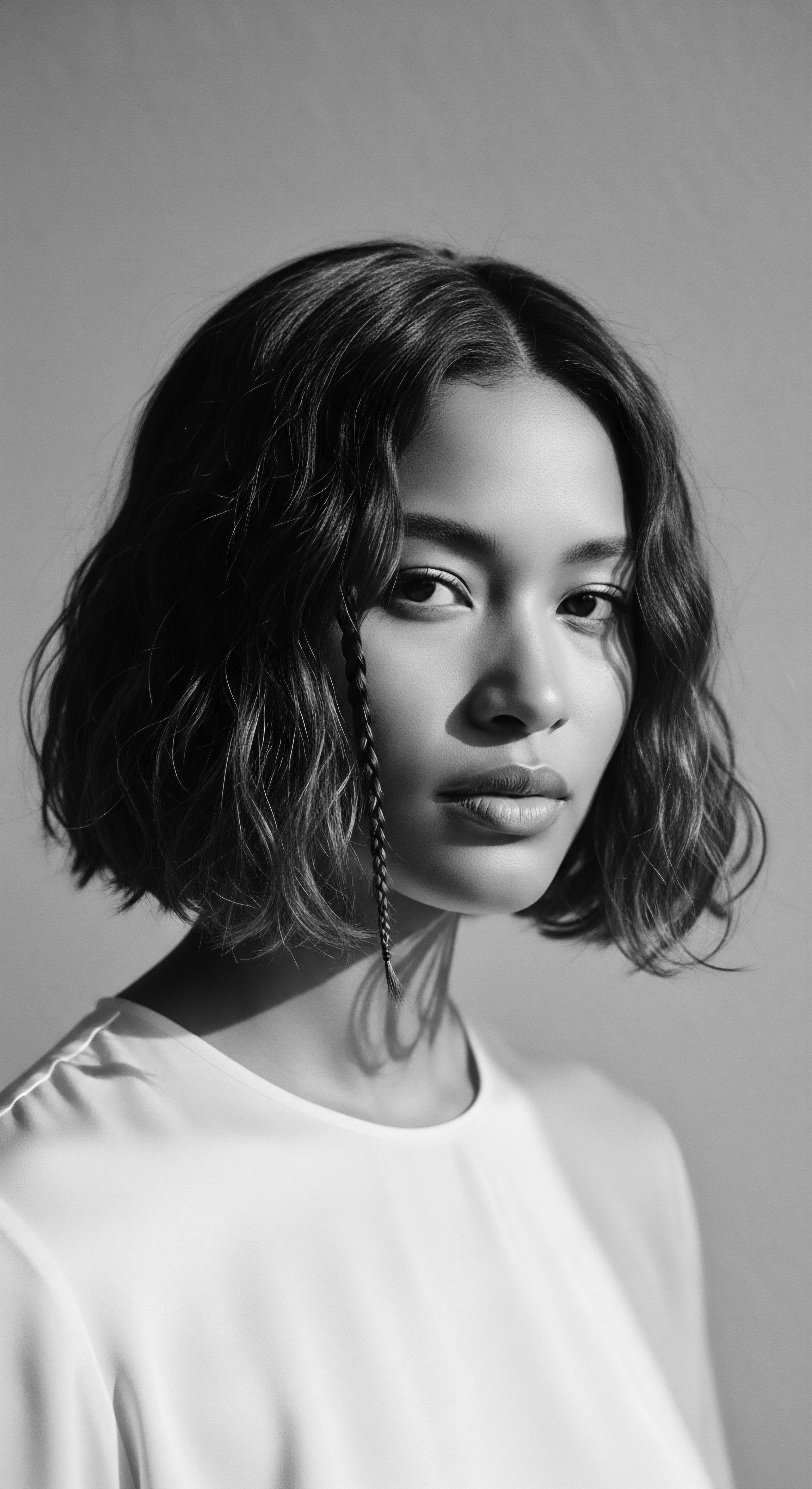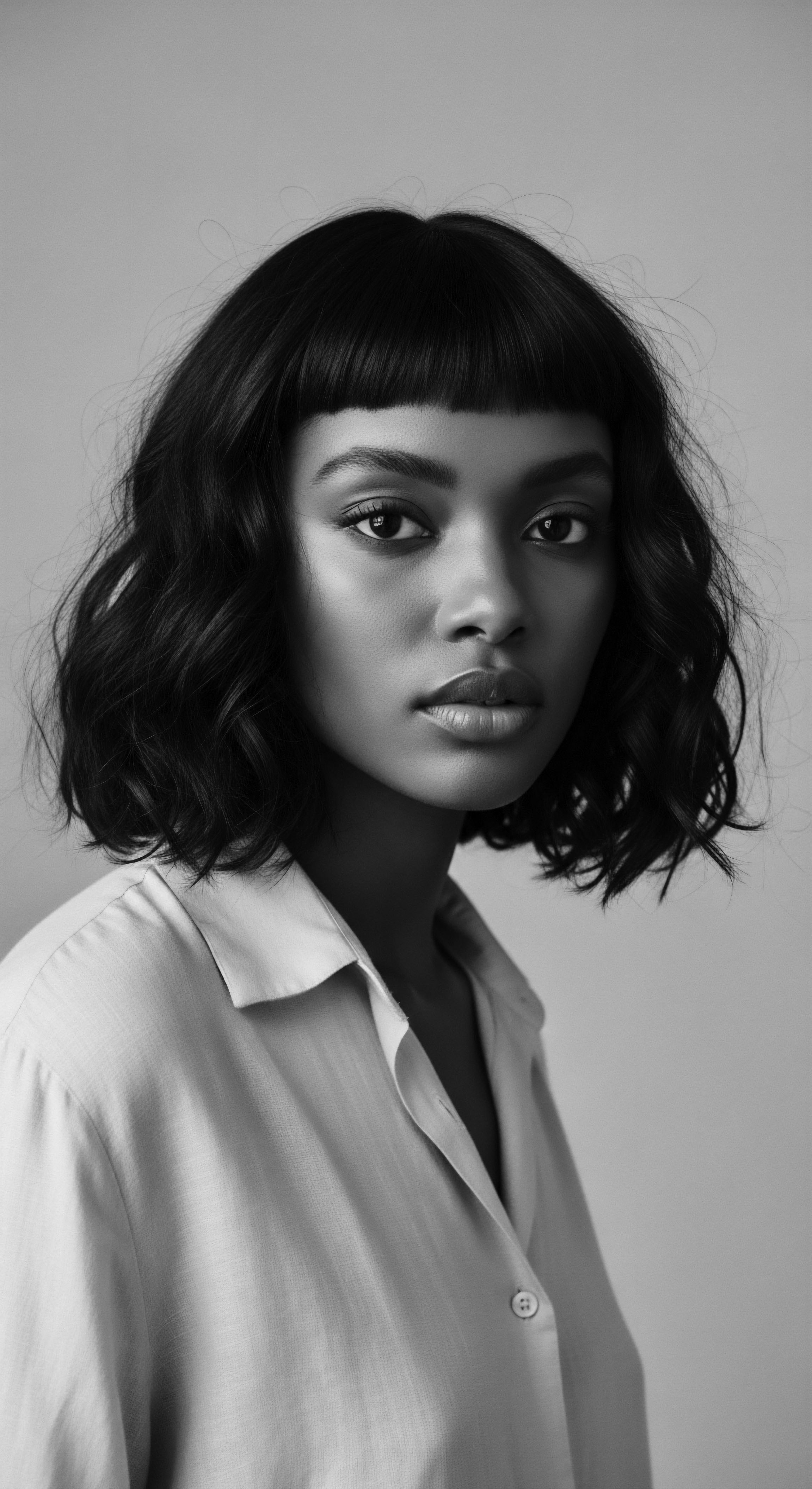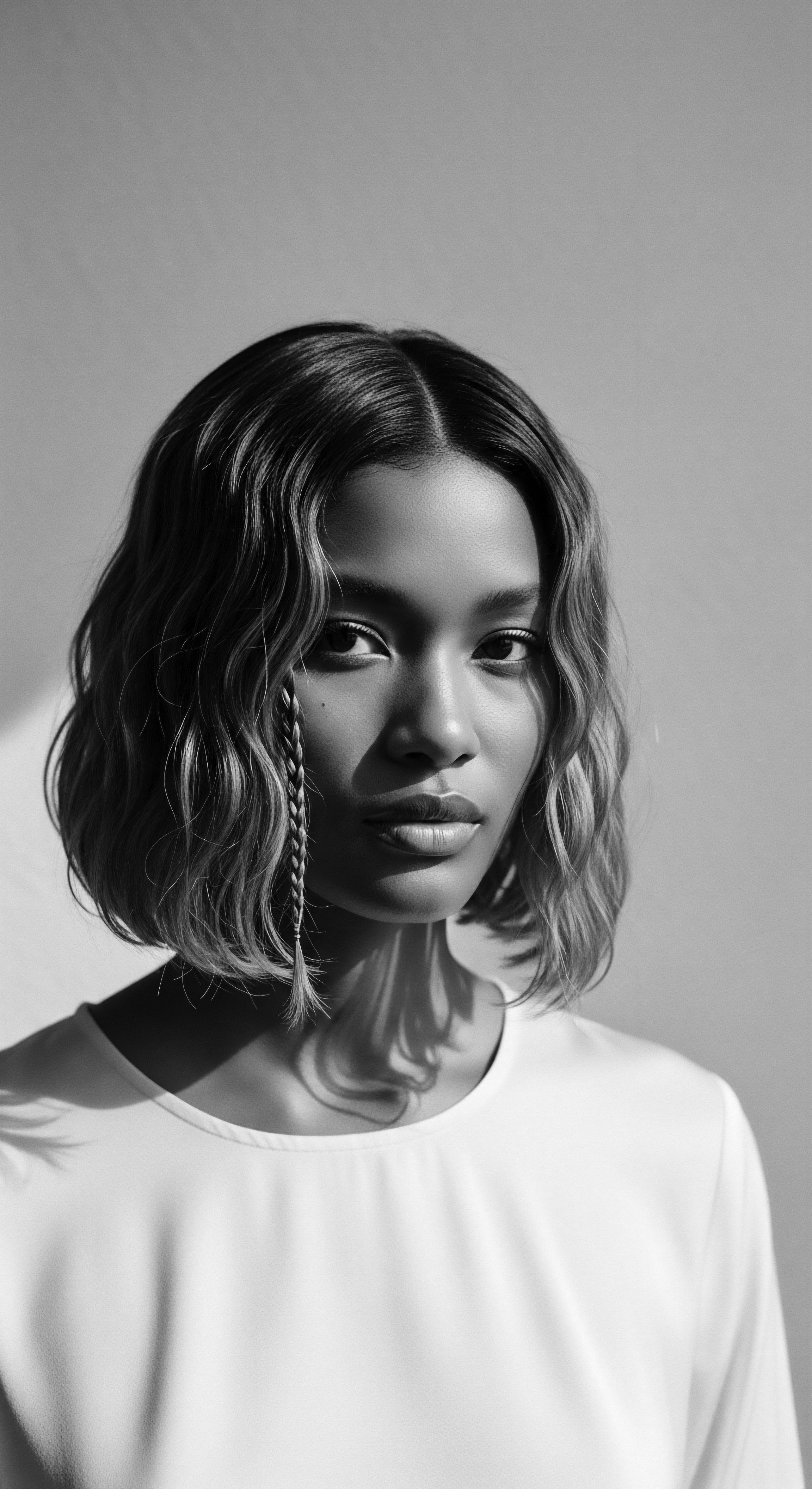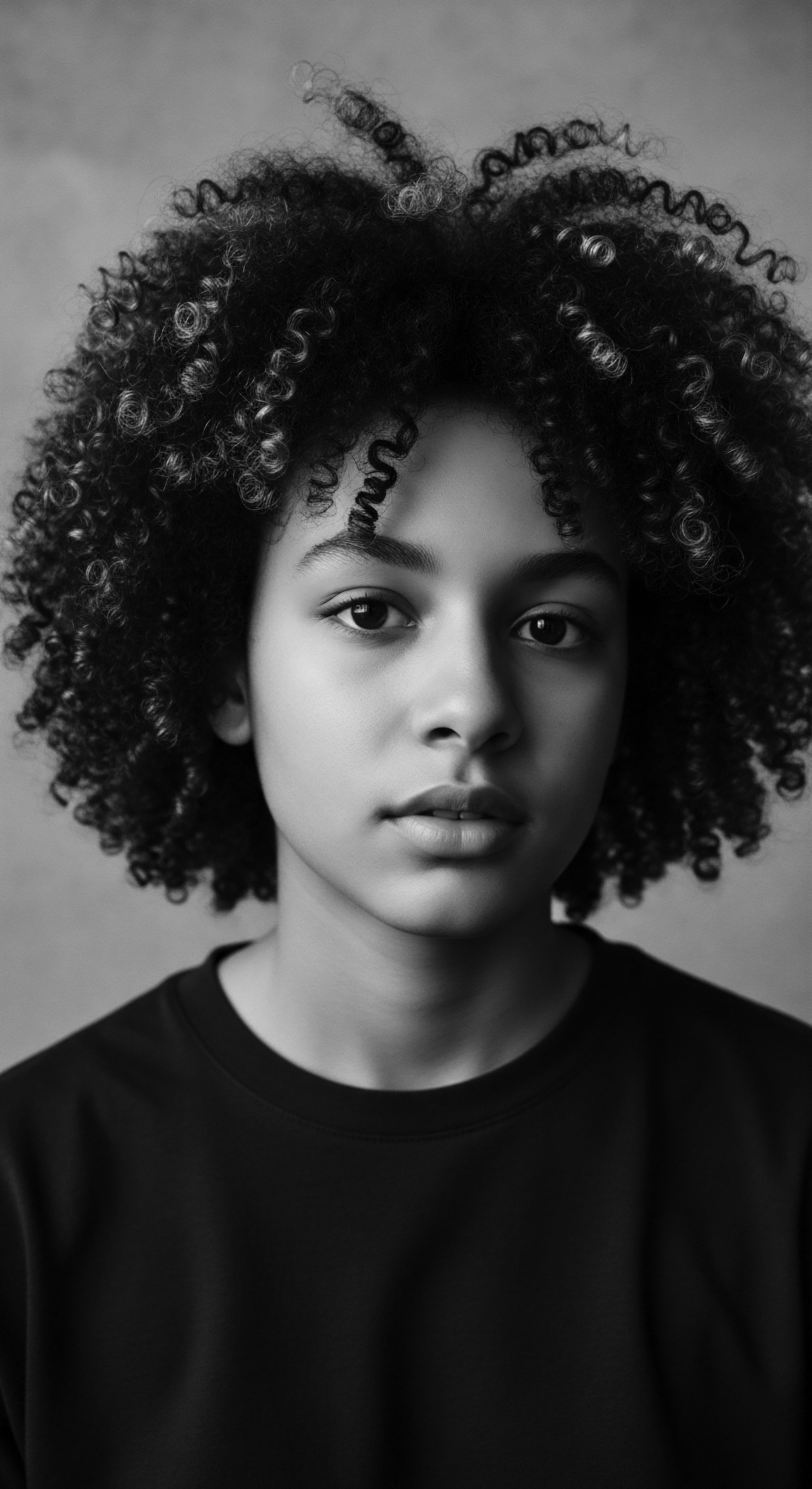
Fundamentals
The understanding of Textured Hair Care, at its very genesis, is a deeply rooted conversation with the land and ancestral wisdom, particularly for those whose lineage carries the legacy of coils, kinks, and waves. This is not merely a regimen of cleansing and conditioning; it is a profound acknowledgment of the hair’s intrinsic design, a design that whispers tales of resilience and beauty across generations.

Echoes from the Source ❉ Ancient Reverence for the Strand
From the sun-drenched landscapes of ancient Kemet to the vibrant communities across the African continent, the care of textured hair was never separated from one’s spiritual well-being or communal identity. Ancient Egyptians, for instance, meticulously crafted unguents and balms from castor oil, moringa oil, and beeswax to maintain the health and adornment of their braided and coiled styles. These practices, far from being superficial, served as daily rituals connecting individuals to their heritage and the rhythms of nature.
The initial perception of Textured Hair Care emerged from ancestral reverence for hair as a vital conduit of spirit and identity, deeply intertwined with natural resources and community life.
The earliest documented approaches to hair preservation, often found in archaeological discoveries and hieroglyphic texts, reveal a sophisticated understanding of botanical properties. Women and men alike utilized natural clays, plant extracts, and animal fats, not only for their cleansing properties but also for their ability to moisturize, protect, and style the hair. Such practices underscore a fundamental truth ❉ the earliest forms of Textured Hair Care were holistic, encompassing physical health, spiritual connection, and communal belonging. Hair in pre-colonial African societies was a powerful symbol, conveying marital status, age, religion, ethnic identity, wealth, and communal rank.
The spiritual significance of hair was also deeply embedded in these ancient societies. Many believed hair, given its close location to the skies, acted as a medium for spiritual interaction with deities and ancestors. It was considered to contain a person’s spirit, holding enough power for use in casting spells, offering protection, or adding potency to medicine. Leaders within a community, both men and women, often wore the most ornate styles, further emphasizing the hair’s symbolic weight.
The concept of Textured Hair Care, therefore, began as an integral part of life, a practice woven into the fabric of daily existence and ceremonial rites. It reflected a deep respect for the body and its connection to the spiritual and natural worlds. The knowledge of which plants, oils, and techniques best suited specific hair types was passed down through oral traditions, hands-on teaching, and communal gatherings, forming a living library of wisdom that predates formal scientific inquiry. This shared wisdom was not merely about aesthetic appeal; it concerned maintaining a connection to one’s lineage and cultural legacy.
The preparation of these early hair care substances often involved intricate processes, from pressing oils from seeds to grinding herbs into powders. These methods highlight an artisanal approach to beauty, where the creation of care products was as much a ritual as their application. The careful selection of ingredients, often locally sourced, demonstrates an inherent understanding of natural resources and their beneficial properties for textured strands.
- Shea Butter ❉ Derived from the nuts of the shea tree, indigenous to West Africa, this rich butter has been a staple for centuries, revered for its profound moisturizing and protective qualities, particularly for coils and curls.
- Castor Oil ❉ Extracted from the seeds of the castor plant, this thick oil has been a traditional remedy in African and Caribbean hair care, known for its ability to promote growth and thickness.
- Chebe Powder ❉ Originating from the Bassara/Baggara Arab tribe in Chad, this powder, made from dried and ground Chebe seeds, is traditionally mixed with water and applied to hair to promote length retention and strength.

Intermediate
As the currents of history shifted, so too did the practical applications and profound meaning of Textured Hair Care. The passage of heritage practices through time and across continents speaks volumes about the resilience of spirit and the adaptability of ancestral wisdom. This evolution is particularly evident in the journey of Black and mixed-race hair, where traditional care rituals transformed into powerful acts of cultural preservation and self-affirmation amidst adversity.

The Tender Thread ❉ Continuity and Adaptation in the Diaspora
The transatlantic slave trade marked a brutal rupture, yet it failed to extinguish the deep-seated reverence for hair. Enslaved Africans, stripped of their language, names, and dignity, often had their heads shaved as a deliberate act of dehumanization and cultural erasure. Despite these profound attempts to sever ties to their heritage, enslaved individuals found ingenious ways to maintain hair traditions. They used whatever meager resources were available, from discarded fabrics as headwraps to animal fats and plant oils like palm oil, to care for their hair and scalp.
Cornrows, a braiding style with origins tracing back to 3000 BCE in Africa, took on new significance in the Americas. These intricate patterns, once indicators of tribal affiliation, age, or marital status, became covert communication tools. Enslaved women would braid specific patterns into their hair to convey messages, indicate escape routes on plantations, or even hide seeds for planting after escape, a testament to their resourcefulness and determination to survive. This profound act of defiance highlights how Textured Hair Care became a clandestine language of liberation and a tangible link to a stolen past.
The adaptation of ancestral hair care rituals into acts of resistance during the transatlantic slave trade profoundly shaped the meaning of Textured Hair Care as a symbol of survival and cultural continuity.
The communal aspect of hair care, a cornerstone of African societies where braiding sessions were times of bonding and storytelling, persisted in the diaspora. Despite the harsh realities of plantation life, women gathered, often in secret, to tend to each other’s hair, sharing knowledge, solace, and strength. This collective ritual became a vital space for community building and emotional support, solidifying the social dimension of Textured Hair Care.
As generations passed, the meaning of Textured Hair Care continued to evolve. Post-slavery, and particularly during the early 20th century, the pressure to conform to Eurocentric beauty standards led many Black women to straighten their hair using hot combs and chemical relaxers. This shift was often driven by a desire for social acceptance and economic opportunity, as straighter hair was often associated with privilege and a perceived higher status. However, even within this context, innovators like Madam C.J.
Walker, herself a daughter of formerly enslaved parents, revolutionized the hair care industry by developing products specifically for Black women’s hair. Her enterprise, built from the ground up, not only provided solutions for scalp ailments and hair growth but also created unprecedented wealth and employment opportunities for Black women, establishing a powerful legacy of Black entrepreneurship within Textured Hair Care. (Bundles, 2002, p. 137)
The resilience of textured hair, and the practices developed to care for it, stand as a testament to an enduring cultural spirit. The methods, whether traditional or adapted, reflect a deep practical knowledge of how to nourish and protect hair that is inherently susceptible to breakage due to its unique structure. The application of natural oils, the use of protective styles, and the understanding of moisture retention have been central to these practices across centuries.
The very terminology surrounding Textured Hair Care has shifted over time, reflecting changing social attitudes and a reclaiming of identity. Terms like “kinky” and “nappy,” once used pejoratively, have been re-appropriated by many as terms of endearment and pride, celebrating the natural state of Black hair. This linguistic transformation mirrors the broader cultural movement towards embracing and celebrating natural textured hair.
| Historical Period Pre-Colonial Africa |
| Key Practices/Ingredients Braiding, threading, oiling with shea butter, castor oil, moringa, plant extracts, clays. |
| Cultural Significance Identity marker (status, age, tribe, religion), spiritual connection, communal bonding. |
| Historical Period Slavery Era (Diaspora) |
| Key Practices/Ingredients Headwraps, cornrows as maps, minimal oils (animal fats, palm oil), hidden seeds. |
| Cultural Significance Resistance, secret communication, survival, cultural preservation, dignity. |
| Historical Period Post-Slavery to Mid-20th Century |
| Key Practices/Ingredients Hot combs, chemical relaxers, hair greases (e.g. Madam C.J. Walker's formulations). |
| Cultural Significance Social assimilation, economic opportunity, Black entrepreneurship, beauty standards. |
| Historical Period Civil Rights/Black Power Era (1960s-70s) |
| Key Practices/Ingredients Afro, natural styles (braids, locs). |
| Cultural Significance Political statement, Black pride, unity, rejection of Eurocentric norms. |
| Historical Period Each era reveals how Textured Hair Care has served as both a practical necessity and a powerful medium for expressing identity and heritage. |

Academic
Textured Hair Care, from an advanced scholarly perspective, is an intergenerational epistemology—a system of knowledge, belief, and ritual—for the preservation, adornment, and symbolic articulation of identity, particularly within Black and mixed-race communities. This comprehensive meaning encompasses not only the biophysical specificities of highly coiled hair structures but also the profound historical, socio-cultural, and psychological dimensions that have shaped its practices and perceptions across millennia. It is a living archive of resilience, adaptation, and cultural sovereignty, continually informed by ancestral wisdom, colonial impacts, and diasporic innovations, with contemporary science now providing frameworks for understanding its enduring efficacy.

The Unbound Helix ❉ Intersections of Biology, History, and Identity
The intrinsic biology of textured hair, characterized by its elliptical follicle shape, uneven keratin distribution, and multiple points of curl torsion, renders it inherently susceptible to dryness and breakage. This structural uniqueness necessitates a care regimen that prioritizes moisture retention, gentle manipulation, and protective styling. Ancestral practices, long before the advent of modern trichology, intuitively addressed these very needs.
The use of occlusive oils, hydrating plant extracts, and protective braiding patterns were not coincidental; they were empirically derived solutions passed down through generations, demonstrating an indigenous scientific understanding of hair’s requirements. For example, traditional African hair oiling practices, using substances like shea butter and various seed oils, effectively seal moisture into the hair shaft, reducing the likelihood of fracture, a benefit now supported by modern research on lipid penetration and cuticle softening.
From an anthropological lens, Textured Hair Care serves as a tangible link to ancestral homelands and a continuous thread of cultural identity. The forced migration of enslaved Africans necessitated the reinvention of care practices, transforming them into clandestine acts of resistance and communal solidarity. Cornrows, for instance, became coded maps for escape routes, and braided styles often concealed seeds to sustain freedom seekers.
This historical example underscores how hair care transcended mere aesthetics, becoming a vital tool for survival and a defiant assertion of selfhood in the face of systemic dehumanization. The deliberate shaving of enslaved Africans’ heads upon arrival in the Americas was a profound act of cultural erasure, yet the persistence of hair traditions highlights an unyielding spirit.
The intricate connection between textured hair’s unique biological structure and its ancestral care practices reveals an inherent, profound understanding of its needs, predating formal scientific inquiry.
The socio-economic implications of Textured Hair Care have also been profound, particularly within the Black diaspora. The emergence of the Black hair care industry, pioneered by figures like Madam C.J. Walker, was a direct response to the unmet needs of Black women and the systemic exclusion from mainstream beauty markets. Walker’s enterprise, documented by A’Lelia Bundles in On Her Own Ground ❉ The Life and Times of Madam C.J.
Walker, provided not only products but also economic empowerment and a sense of dignity for countless Black women, establishing a parallel economy rooted in communal needs. This industry, even amidst economic downturns, has consistently demonstrated remarkable resilience, with Black consumers spending billions annually on hair care, often two to six times more than their white counterparts. This expenditure, however, also reflects historical pressures to conform to Eurocentric beauty standards, leading to the prevalence of chemical relaxers and high-tension styles that, while offering perceived social advantages, have been linked to dermatological issues such as traction alopecia.
The contemporary natural hair movement represents a powerful cultural reclamation, a conscious return to ancestral aesthetics and care philosophies. This movement, fueled by digital platforms and a collective desire for self-acceptance, has shifted consumer preferences away from chemical straightening towards products and practices that honor natural texture. This return is not simply a trend; it is a profound socio-cultural phenomenon, echoing the Black is Beautiful movement of the Civil Rights era, which utilized the Afro as a symbol of racial pride and resistance against oppressive beauty norms.
The academic discourse surrounding Textured Hair Care thus extends beyond mere product efficacy, encompassing the complex interplay of historical trauma, cultural resilience, economic agency, and evolving identity. It calls for a holistic understanding that values both empirical scientific validation and the deep, embodied knowledge passed down through generations. The meaning of Textured Hair Care is therefore a dynamic, living concept, continually re-shaped by the experiences and aspirations of those who wear and cherish textured hair.

Ancestral Practices and Modern Validation ❉ A Symbiotic Relationship
A fascinating area of study within Textured Hair Care involves the scientific validation of long-standing ancestral practices. For instance, the traditional use of certain plant oils in African hair care, such as Abyssinian seed oil, has been shown to offer concrete benefits like maintaining cortex strength, mitigating solar radiation-induced melanin degradation, and increasing cuticle softness. This scientific affirmation of traditional knowledge highlights a symbiotic relationship between ancient wisdom and contemporary research. It suggests that many historical methods were not arbitrary but were based on an astute, albeit uncodified, understanding of hair biology and environmental factors.
The practice of hair threading, known as “Irun Kiko” among the Yoruba people of Nigeria as early as the 15th century, offers another compelling example. This technique, involving wrapping hair with thread, was believed to bring good fortune and is now recognized for its efficacy in length retention and achieving heatless blowouts. Such continuity demonstrates how cultural practices have preserved effective hair care methods that are only now being fully appreciated through modern scientific lenses.
The ongoing economic landscape of Textured Hair Care continues to grapple with issues of ownership and market control. While Black consumers drive a significant portion of the hair care market, there has been a historical trend of larger, non-Black corporations acquiring Black-owned businesses, leading to concerns about the authenticity and cultural sensitivity of products. This phenomenon underscores the ongoing struggle for self-determination within the industry, a struggle that is deeply rooted in the historical context of hair as a symbol of autonomy and economic power.
The study of Textured Hair Care, therefore, necessitates an interdisciplinary approach, drawing from ethnobotany, anthropology, dermatology, sociology, and economics. It is a field that offers rich opportunities for exploring the complex interplay of biological realities, cultural narratives, and socio-political dynamics. The meaning of Textured Hair Care, at its most advanced level, is a testament to the enduring human capacity for innovation, resilience, and the profound articulation of identity through the seemingly simple act of tending to one’s strands.

Reflection on the Heritage of Textured Hair Care
As we consider the vast expanse of Textured Hair Care, we find ourselves standing at the confluence of ancient rivers and modern streams, where every coil and curl tells a story of survival, artistry, and spirit. This is more than a mere collection of practices; it is a living legacy, a testament to the indomitable ‘Soul of a Strand’ that has journeyed through time, absorbing the sun’s warmth, the sting of adversity, and the gentle touch of caring hands. The very fibers of textured hair carry the whispers of ancestors, their wisdom encoded in the enduring rituals of care and adornment.
From the communal gatherings where braids were meticulously crafted, each pattern a map or a message, to the quiet resilience of those who found dignity in a carefully wrapped headscarf, the heritage of textured hair care has been a steadfast companion. It has been a source of both profound connection and defiant expression, a silent language spoken through styles that proclaimed identity and resisted erasure. The evolution of these practices, from the elemental balms of ancient Africa to the sophisticated formulations of today, reflects an unbroken chain of knowledge—a profound understanding of nature’s gifts and the hair’s inherent needs.
This enduring journey reminds us that Textured Hair Care is an act of profound self-love and cultural affirmation. It is an acknowledgment that beauty is not monolithic, but a vibrant spectrum, celebrated in every unique twist and turn of a strand. The heritage we inherit compels us to approach our hair with reverence, recognizing its deep roots in history and its powerful voice in the present. As we look to the future, we carry forward this living library of wisdom, ensuring that the stories, the science, and the soulful essence of textured hair continue to thrive, unbound and gloriously free.

References
- Bundles, A. (2002). On Her Own Ground ❉ The Life and Times of Madam C. J. Walker. Scribner.
- Byrd, A. D. & Tharps, L. R. (2001). Hair Story ❉ Untangling the Roots of Black Hair in America. St. Martin’s Press.
- Patton, T. O. (2006). Our Hair, Our Heritage ❉ The Story of Black Hair in America. Praeger.
- Morrow, W. L. (1973). 400 Years Without A Comb. Morrow’s Unlimited, Inc.
- Jacobs-Huey, L. (2006). From the Kitchen to the Salon ❉ The Social History of Black Hair Care. Routledge.
- Mercer, K. (1994). Welcome to the Jungle ❉ New Positions in Cultural Studies. Routledge. (Contains essays on black hair and identity).
- Banks, I. (2000). Hair ❉ A Cultural History of Hair Fashion in America. W. W. Norton & Company.
- Akerele, O. (1993). Indigenous Knowledge Systems and Hair Care in Africa. Journal of Ethnopharmacology, 39(2), 113-120.
- Okoro, N. (2010). The Cultural Politics of Black Hair. Palgrave Macmillan.
- Dixon, C. (2005). Braids ❉ The History and Cultural Significance of African Hair Braiding. The Black Scholar, 35(4), 18-25.
- Fernandez, M. (2025). Cultural Narratives of Caribbean Braiding ❉ Self-Care and Community Building. (Cited as cultural anthropologist Dr. Maria Fernandez in search results).
- Lukate, N. (2022). Braids as a form of self-expression and cultural significance. (Cited in search results as Lukate, 2022).
- Ogunbiyi, T. (1963). Should Negro Women Straighten Their Hair. Black World/Negro Digest.
- Ayanlowo, O. O. & Otrofanowei, F. A. (2023). Braiding styles are diverse and often reflect ethnic traditions, religious affiliations, and individual preferences. (Cited in search results as Ayanlowo & Otrofanowei, 2023).
